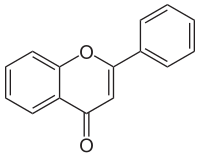
Photo from wikipedia
Flavonoid glycosides are typical bitter and astringent tasting compounds that contribute to the taste of tea beverages. However, the genes that contribute to the biosynthesis of bitter compounds (e.g., flavanone… Click to show full abstract
Flavonoid glycosides are typical bitter and astringent tasting compounds that contribute to the taste of tea beverages. However, the genes that contribute to the biosynthesis of bitter compounds (e.g., flavanone 7-O-neohesperidoside) in tea plants have yet to be identified. In this study, we identified 194 UDP-glycosyltransferases (UGTs) from the tea transcriptome database. Among them, two genes, CsUGT75L12 and CsUGT79B28, encoding flavonoid 7-O-glycosyltransferase and 7-O-glucoside(1→2)rhamnosyltransferase, respectively, were identified from Camellia sinensis. In vitro, the purified recombinant enzyme rCsUGT75L12 specifically transports the glucose unit from UDP-glucose to the 7-OH position of the flavonoid to produce the respective 7-O-glucoside. rCsUGT79B28 regiospecifically transfers a rhamnose unit from UDP-rhamnose to the 2″-OH position of flavonoid 7-O-glucosides to produce flavonoid 7-O-di-glycosides. Additionally, the expression profiles of the two CsUGTs were correlated with the accumulation patterns of 7-O-glucoside and 7-O-neohesperidoside, respectively, in tea plants. These results indicated that the two CsUGTs are involved in the biosynthesis of bitter flavonoid 7-O-neohesperidoside through the sequential glucosylation and rhamnosylation of flavonoids in C. sinensis. Taken together, our findings provided not only molecular insights into flavonoid di-glycoside metabolism in tea plants but also crucial molecular markers for controlling the bitterness and astringent taste of tea.
Journal Title: Journal of agricultural and food chemistry
Year Published: 2022
Link to full text (if available)
Share on Social Media: Sign Up to like & get
recommendations!